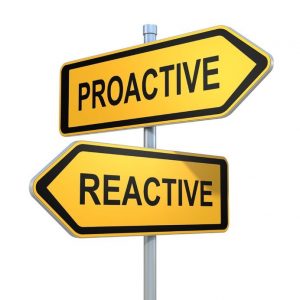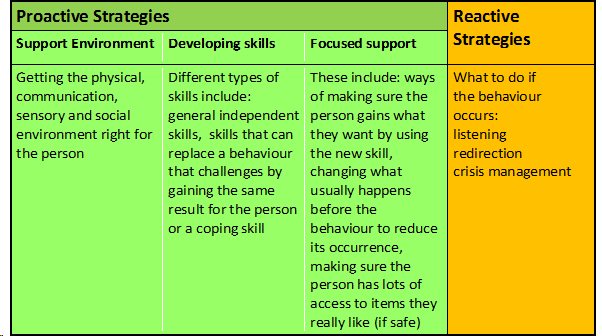Adults and children with disabilities can be at greater risk of presenting with behaviours that challenge (Department of Health Nice Guidelines: Challenging Behaviour and Learning Disabilities 2015). There are widely recognised reasons for this additional vulnerability, such as the environment not meeting the person’s communication or independent skill needs. Due to the nature of behaviours that challenge the person themselves and others can be at risk of physical harm due behaviours such as hitting out at others or self-injurious behaviour. Most organisations and schools providing support and education for people with disabilities will have some form of behaviour management training for their staff as a way of mitigating against injury and to keep the person safe. This involves the use of non-physical approaches such as reflective listening and distraction techniques; personal safety or breakaway techniques; and restrictive interventions such as restraints which should only be used as an absolute last resort.
This training can provide staff with the tools to manage behavioural challenges when they are occurring (reactive strategies) but it provides only minimal training in the proactive approaches which can be put into place when the behaviour is not occurring. Putting into place effective strategies in this proactive ‘time zone’ is critical if you want to really reduce the likelihood of the behaviour occurring again in the future.
While there are many good behaviour management training systems which discuss the importance of proactive approaches, the very nature of behaviour management training is focussed on managing behaviour challenges when they occur. Staff spend the majority of the training practicing the physical techniques, because they require lots of practice to ensure competence. As a result when staff think about behaviours that challenge, what is the first thing they think about and remember? …………listen, distract, block, deflect and restrain as a last resort.
As a result the behaviour continues to occur as it is only managed in the moment with increasing consequences for all, not least the person themselves, as it continues into the future. So is the behaviour really being ‘effectively managed’ if it continues to occur over the longer term? Arguably not.
What may not be clear for some senior managers commissioning ‘behaviour management’ training is that whilst many packages will talk about positive behaviour support or positive management and they will include discussions about proactive approaches, their staff are only really being trained to competence in reactive approaches. This will not reduce the occurrence of the behaviour in the future. To balance this staff require training where the focus is primarily on proactive approaches with a strong value base around how people with disabilities should be supported. Training where the focus is on increasing quality of life and the development of new skills. Ideally this training is on a different day to be really clear about the difference between proactive and reactive approaches. The table below provides a summary of both proactive and reactive strategies. It shows the breadth of proactive interventions and helps to illustrate that there should be greater emphasis on these elements of a PBS plan.
Lavigna and Willis (1995) Model of Positive Behaviour Support
While full competence in proactive approaches requires training to professional levels (see PBS Academy competence framework http://pbsacademy.org.uk/) training staff teams to implement a number of environmental interventions and teach new skills can reduce a significant amount of behavioural challenges while making significant increases in quality of life for the person supported.
For organisations supporting adults there is clear Department of Health guidance on proactive, reactive interventions and positive behaviour support in the document Positive and Proactive Care. For services supporting or educating children guidance is planned but has not yet been released. However, the Challenging Behaviour Foundation have released a short guidance document for children’s services. See links for both documents below.
© Redstone PBS 2017
Redstone Tip
Consider your behaviour management strategy or policy. Is it focussed largely on reaction? Are you getting the improvements you want in terms of reductions in incidents of behaviours that challenge? What is in place to support the development of alternative behaviours? What do staff/carers do in between ‘challenging’ times? Do they have a clear proactive strategy to support the person to increase their quality of life, skills, activity and communication? If not, what do you or your organisation need to do to put proactive interventions in place?
If you’re interested in further blogs and videos sign up here
References
LaVigna G and Willis T (1995) A multi-element approach for breaking the barriers to social and community integration. Available at http://www.iaba.com/article/htm.
Positive and Proactive Care link https://www.gov.uk/government/uploads/system/uploads/attachment_data/file/300293/JRA_DoH_Guidance_on_RP_web_accessible.pdf
Challenging Behaviour Foundation link http://www.challengingbehaviour.org.uk/learning-disability-assets/statementonrestrictivephysicalinterventionswithchildren.pdf
 Author- Kate Strutt – Bsc Psychology, D.Clin Psyc, Currently completing Msc in Applied Behaviour Analysis.
Author- Kate Strutt – Bsc Psychology, D.Clin Psyc, Currently completing Msc in Applied Behaviour Analysis.
Director of Redstone and clinical psychologist with over 18 years’ experience of working in intellectual disability and autism services, both within statutory services and the independent sector. Kate is a member of the British Psychological Society and is registered with the Health and Care Professions Council.









